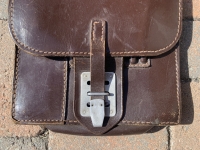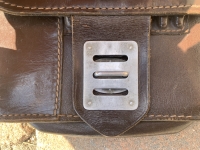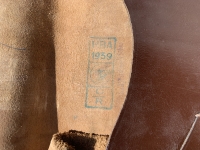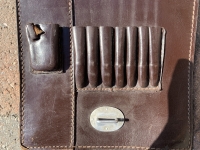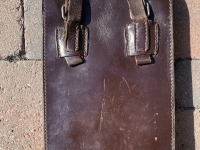BACKGROUND: Map/dispatch cases were issued on a limited basis to specifically designated personnel such as unit commanders, messengers, and observers. The M35 map/dispatch case was based on the Weimar era, Reichsheer pattern map/dispatch case with minor variations. The M35 map/dispatch case underwent a front closure modification in mid-1936, and an additional small front pocket was added in 1938, although the early pattern cases continued to be manufactured throughout the war. The M35 map/dispatch cases were issued with assorted map reading tools, instruments and accessories. Of Note: As with other armies the Germans had a Kriegskarten- und Vermessungswesen Abteilung, (War Maps and Surveying Department), under command of the OKH, Oberkommando des Heeres, (High Command of the Army). The war maps and surveying department was responsible for all army issue maps and worked in conjunction with the German Reichsamt für Landesaufnahme, (National Land Survey Office). Regulations dictated that army issue maps were exclusively for use of army personnel and that any reproduction or improper usage were punishable offences. German army maps were generally named and numbered and were issued as require
PHYSICAL DESCRIPTION: Brown, pebbled leather construction, first pattern, M35 map/dispatch case with steel fittings. The case is roughly, 27cm tall, and 19cm wide, and 5cm thick, with folding, accordion, expanding side panels. The case has a fold over top closure flap with a machine stitched on, vertical closure strap which attaches to a leather reinforced, magnetic sheet metal, pronged roller buckle which is machine stitched to the bottom center of the cases body. The front of the case features a vertical ruler pocket to the left side, seven central, vertical pencil holders and a small vertical pocket to the right side with an internal quick release pull tab. When in the closed position the top fold over flap covers the top openings of the ruler, pencil and tool pockets to ensure against losing the items. The reverse of the case has two, machine stitched on, vertical belt loop straps with magnetic sheet metal, pronged length adjustment roller buckles. The natural tan leather interior of the case has two compartments with a central, blackened, simulated leather separating panel. The interior of the case also has protective panels to both of the top side panels positioned underneath the top fold over flap. Maker stamped to the inside top flap PBA 1939. A wonderfully well preserved original piece of Wehrmacht field equipment.
$200
Please call, text or email me if interested.
Tel/Text: 1-438-502-5052
Email Us: helmetsofwar@gmail.com
GERMAN HELMET FACTORY PRODUCTION CODES
(Every original German helmet produced from 1935 to 45 had two factory stampings punched into the side and rear or both in the rear. The alpha numeric number refers to the factory location and the inside metric circumference in centimeters. The rear lot number refers to the production run and was used as a quality control measure. The font styles used at each factory were slightly different but highly consistent throughout the war and so fakes or reproductions will either not have these numbers at all or they will use the wrong font style or letter spacing and so are easily identified as post war made.)
(FS or EF)-Emaillierwerke AG, Fulda, Germany
(ET or ckl)-Eisenhuttenwerke, Thale, Germany
(Q)-Quist, Esslingen, Germany
(NS)-Vereinigte Deutsche Nikelwerke, Schwerte, Germany
(SE or hkp)-Sachsische Emaillier u. Stanzwerke, Lauter, Germany

